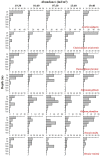The diel vertical distribution and carbon biomass of the zooplankton community in the Caroline Seamount area of the western tropical Pacific Ocean
- PMID: 36344650
- PMCID: PMC9640698
- DOI: 10.1038/s41598-022-23522-0
The diel vertical distribution and carbon biomass of the zooplankton community in the Caroline Seamount area of the western tropical Pacific Ocean
Abstract
Zooplankton can affect and regulate the biological carbon pump in the biogeochemical cycles of marine ecosystems through diel vertical migration (DVM) behaviour. The diel vertical distribution and migration of a zooplankton community were studied at a continuous survey station in the Caroline Seamount area of the western tropical Pacific Ocean. Using a MultiNet sampling system, 346 zooplankton species/taxa were collected and identified. The vertical distribution patterns of abundance and composition of the zooplankton community differed between daytime and nighttime. The highest biodiversity index occurred in the 100-200-m ocean depth layer, but some zooplankton species remained in the deep-water layer below 300 m. The DVM patterns of the various dominant species differed, even when the species belonged to the same order or family. Dissolved oxygen and seawater temperature were the main environmental factors affecting the diel vertical distribution of the zooplankton community. The oxygen minimum zone was identified as performing the dual role of "ecological barrier" and "refuge" for zooplankton. The active carbon flux mediated by the zooplankton DVM in the Caroline Seamount area was 14.5 mg C/(m2·d). Our findings suggest that zooplankton DVM can affect and mediate the biological carbon pump in the Caroline Seamount area.
© 2022. The Author(s).
Conflict of interest statement
The authors declare no competing interests.
Figures








Similar articles
-
Seasonal and diel variations in the vertical distribution, composition, abundance and biomass of zooplankton in a deep Chilean Patagonian Fjord.PeerJ. 2022 Jan 25;10:e12823. doi: 10.7717/peerj.12823. eCollection 2022. PeerJ. 2022. PMID: 35127292 Free PMC article.
-
Diel vertical migration of Arctic zooplankton during the polar night.Biol Lett. 2009 Feb 23;5(1):69-72. doi: 10.1098/rsbl.2008.0484. Biol Lett. 2009. PMID: 18948249 Free PMC article.
-
Hydroids (Cnidaria, Hydrozoa) from Mauritanian Coral Mounds.Zootaxa. 2020 Nov 16;4878(3):zootaxa.4878.3.2. doi: 10.11646/zootaxa.4878.3.2. Zootaxa. 2020. PMID: 33311142
-
Effects of shallow-water hydrothermal venting on biological communities of coastal marine ecosystems of the western Pacific.Adv Mar Biol. 2006;50:267-421. doi: 10.1016/S0065-2881(05)50004-X. Adv Mar Biol. 2006. PMID: 16782453 Review.
-
The biological carbon pump, diel vertical migration, and carbon dioxide removal.iScience. 2023 Sep 20;26(11):107835. doi: 10.1016/j.isci.2023.107835. eCollection 2023 Nov 17. iScience. 2023. PMID: 38026165 Free PMC article. Review.
Cited by
-
Diel variations in planktonic ciliate community structure in the northern South China Sea and tropical Western Pacific.Sci Rep. 2023 Mar 8;13(1):3843. doi: 10.1038/s41598-023-30973-6. Sci Rep. 2023. PMID: 36890185 Free PMC article.
References
-
- Roemmich D, Mcgowan J. Climatic warming and the decline of zooplankton in the California current. Science. 1995;267(5202):1324–1326. - PubMed
-
- Biard T, Stemmann L, Picheral M, Mayot N, Vandromme P, Hauss H, et al. In situ imaging reveals the biomass of giant protists in the global ocean. Nature. 2016;532:504–507. - PubMed
-
- Irigoien X, Huisman J, Harris RP. Global biodiversity patterns of marine phytoplankton and zooplankton. Nature. 2004;429:863–867. - PubMed
-
- Ware DM, Thomson RE. Bottom-up ecosystem trophic dynamics determine fish production in the Northeast Pacific. Science. 2005;308(5726):1280–1284. - PubMed
Publication types
MeSH terms
Substances
Grants and funding
LinkOut - more resources
Full Text Sources

